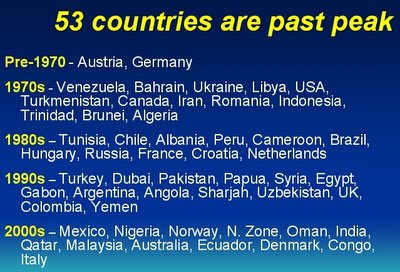One of the main problems with the dieoff is crowd is their assertion that such a scenario is unavoidable. Apart from the diceyness of their data and the failure of their past predictions, the also greatly underestimate the complexity of the future. The future is not simple, nothing in it is inevitable, and doomers do not know more than anyone else. They made this mistake back in the 1970s, and after the reading the Ehrlich's
One with Nineveh and the Club of Rome's new number
Beyond the Limits, it's clear that they don't want to make it again. "If the projected increases in energy use were derived from renewable sources instead of fossil fuels," concedes Ehrlich, "and if the population's peak size could be kept well below 10 billion, the outlook would become considerably brighter" (compare this to the quotes in
#146). These original doomers have now become cautiously optimistic about the ultimate fate of the planet, perhaps because they realise that unless people believe problems can be fixed, they won't try and fix them.
Peak Oil, on the other hand, has been hijacked by a niche community with a fondness for gloomy-looking websites and folk-tales about the grisly end of suburbia, with the Hubbert Peak the unanticipated final straw that will swiftly bring down a well-deserved Malthusian catastrophe on the cancerous mass of humanity. (Read the latest issue of the Magazine "Adbusters" to get a taste of such hysterical fear-mongering.) As long as Peak Oil is associated with this kind of culture it will be viewed as a kooky theory not deserving of public attention. It needs to be rationally examined and recognized for what it is, i.e. another troubling but solvable issue along with Climate Change, environmental degradation and poverty. In other words, Peak Oil needs some context. It's far from the only thing going down on Planet Earth right now, and for this reason I thought I'd share some other trends and ideas that might give some perspective to the whole thing. Please suspend your cynicism, doomers, and enjoy the ride.
An Ecological RevolutionOil is just one part of a larger issue, ie that humans are, and have long been, straining the boundaries of the planet. This is mainly because the current economic system ignores the state of the environment, assuming there will always be more resources and more space to dump the waste. Yet politicians continue to espouse the oxymoron of "sustainable growth", and treat the environment as a separate issue. This is, said economist Herman Daly, like looking only at an animal's circulatory system while ignoring its digestion.
While many people look at this and see disaster, others, like Amory Lovins, see opportunity. His argument is that the current industrial model is an obsolete relic of the 19th century. Back then, we were limited "not by the number of trees but by the number of axes". We used machines to extend human productivity, resulting in the Industrial Revolution. Today, Lovins argues, that situation is reversed: we have too many axes, but we are running out of trees. Hence, we need a Second Industrial Revolution which will reflect these changed realities. Just as the First Industrial Revolution got 200 times more productivity out of each worker, the Second Industrial Revolution will get 200 times more efficiency out of its raw materials. It will view waste as a profit-leaching evil, and appreciate the true value of Natural Capital and the free services that nature provides, reconciling the interests of environmentalism and business. The goal is to minimize the flow of materials by maximising the flow of information.
Lovins is on the right track because, as JD says, our current society is appallingly wasteful. In the book
Natural Capitalism, Lovins and his co-authors give countless examples of how to eliminate this waste with a combination of new technologies, better design, new cultural attitudes and pure common sense. Lovins reckons that pretty much everything produced by industry today is very badly designed, which is true. Examples of good design include the Prius, this
custom-made fridge, and the book
Cradle to Cradle, which is made not out of paper but from a water-resistant synthetic material derived from plastic resins and inorganic fillers. (Link:
http://www.mcdonough.com/cradle_to_cradle.htm).
The idea of an ecological revolution gives a wider frame for our efforts to make the world more sustainable, and this revolution is already in progress all around the world, particularly in Europe. As Lovins points out, societies usually move down the path of least economic resistance, and it’s increasingly the case that sustainable practices are more cost-effective than unsustainable practices (a situation to which Peak Oil will contribute). The situation can only improve since the cost of technology falls exponentially, while non-renewable resources invariably don't. Inflexible old players (like the big car companies, or the United States) must recognize this, or they'll get outpaced by agile newcomers. Why do you think British Petroleum changed its name to Beyond Petroleum, or an array of European countries pledged a "factor four" increase in efficiency, or McDonalds replaced polystyrene containers with biodegradable material?
Neo-CapitalismPerhaps this Revolution goes even further, to the social and economic system itself. There is increasing recognition that GDP is not a good measure of a society's well-being, particularly as it also measures undesirable things like crime and waste. Technology cannot increase efficiency forever, and even if it does we are looking at a population implosion before 2050 as a result of declining birthrates. So maybe it's best to begin transitioning to a Steady State Economy. This would not rule out occasional periods of economic expansion thanks to new technologies or population increases, but it would abandon a 3%-a-year growth of GDP as the overriding preoccupation of policymakers. Instead, they could concentrate on actually improving services and boosting quality of life.
Of course, a Steady State Economy poses some challenges because we have to work out how to adjust our "perfect" economic system to accommodate it. Just as the 19th century gave rise to new social theories and forms of government, so the 21st century will have to perfect "Neo-Capitalism", a tweaked version of the capitalist system which (a) Accounts fully for human dependence on the environment and (b) Does not require constant growth to function. While I'm sure this is possible with Islamic Banking and the elimination of risk-free government loans, perhaps the biggest challenge will be the cultural shift required to defeat the dogma of GDP-worship which currently pervades society.
Nanotechnology and the Kurzweil SingularityImagine that before we've even started adjusting to these changes, something else comes along whose impact far dwarfs anything we've yet experienced, making our social, political and economic systems obsolete, replacing all our challenges with new ones, and raising unprecedented ethical questions about the nature of consciousness and the meaning of life. That something is Nanotechnology.
In the shorter term, Nanotechnology will revolutionise manufacturing by using nano-factories like
this, which can assemble products at the molecular level from a small range of raw materials. The cheap, widespread affordable use of such machines, coupled with extremely cheap energy, would mean that manufactured products basically cease to have monetary value, and the only use of money would be for 'unique' commodities like real estate, antiques or human services. Concerns about population could be diminished by producing food this way. As a result, all the problems that Natural Capitalism and the Steady State Economy tried to address are basically solved, replaced by new ones like how to deal with spiralling unemployment, how to avoid nano-warfare, and how to redesign society from the ground up to accommodate such changes. (Link:
http://www.crnano.org/overview.htm)
The fun doesn't stop here. Ray Kurzweil, a pioneer in text-to-speech, speech-to-text, and music synthesizers, has dedicated much of the recent part of his life to advancing a theory known as "The Singularity". Kurzweil believes that the rate of 'salient events' follows an exponential curve either upward or downward, proportional to the amount of "chaos" in the system. While development of the universe is getting slower and slower, the speeds of both evolution and technological development are speeding up. We are currently approaching a "knee in the curve" where technological advancements happen so fast that within a few decades we will reach a "singularity": a point where life changes so much that it is beyond the capacity of earlier humans to reliably predict or even comprehend – like trying to explain world trade to a caveman.
In
The Age of Spiritual Machines and
The Singularity is Near, Kurzweil predicts, probably correctly, that the power of a $1, 000 computer will soon exceed the human brain. Advances in neuroscience will allow a person to be scanned and transferred into a computer. There will be two intelligent and conscious species on Earth, one evolving faster than the other. Meanwhile, lifespan could be drastically extended by using medical nanobots to fix bits of your body as they deteriorate. Ultimately, the human body could become obsolete altogether as we transfer our consciousnesses into computers where our intelligence could be augmented thousandfold and we could travel independent of physical matter. We could actually "be" a spacecraft or other vehicle, or imbue physical matter with intelligence. Aliens have probably done this already, which would support the old ants vs. humans argument for the current failure of SETI (that aliens are on as different a plane of existence to us as we are to the ants).
The point is that both Richard Duncan and Francis Fukuyama have both announced the "end of history" too soon. The future is a lot more complicated. We're looking at two new Industrial Revolutions, the complete redesign of our social and economic system, and developments that will irrevocably change the nature of life on Earth beyond our present capacity to imagine. These are only some of the possibilities, and you and I could see them all in our lifetimes. What are we complaining about? We live in the most exciting century in human history.
The Naivety of a Simple FutureRight now the doomers are probably saying, "You've got your head in the clouds. If we fall off the Olduvai Cliff then all of this is completely irrelevant". Which is true, but it completely misses the point, just as the hysterical doomer Kurzweil's online forum with scary messages about the dieoff has missed the point. Doomsday scenarios are not obstacles in the way of the future, they're simply undesirable future possibilities that we are trying to avoid. The future is far from simple and it's definitely not certain. That's why the gospel of intractable doom is as damaging to the environmentalist cause as cornucopianism. It's why blind faith in technology is no worse than blind dismissal of it.
In preparing for the future we've got to realise that we can never be quite sure what we're preparing for. It's like someone in the 1880s inventing a machine to clean manure from city streets, and completely failing to foresee the invention of the automobile. Or Arthur C. Clarke in the 1950s figuring out how to support the crew necessary to change the vacuum tubes in his communications satellites, and completely failing to foresee the transistor. Likewise, as a society we've got to prepare for the worst-case scenario – that is, the most "conventional" scenario. But one thing working in the favour of optimism is that there are always wildcards. We've got to work out how to transition to a Steady State Economy, but before we’re done we may find that Nanotechnology made the economy obsolete. We need to solve the immediate challenge of Peak Oil, and work out the finer details of the hydrogen-refuelling infrastructure in the year 2040 … but when the year 2040 rolls around we may find we're living in another dimension.
-- by Roland





















